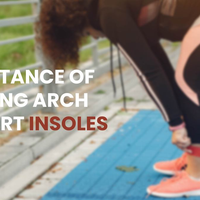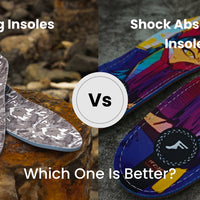What Are the Best Shoe Insoles for Standing All Day?

Standing for prolonged periods can take a toll on your feet, leading to discomfort and even pain. Whether you're a nurse, a retail worker, or someone who spends hours on your feet at work, finding the right shoe insoles can make a world of difference in your comfort level and overall well-being. Here are some tips for finding the best shoe insoles for standing all day:
By investing in the right shoe insoles for standing all day, you can alleviate discomfort, reduce fatigue, and improve your overall well-being. Don't let foot pain hold you back – take care of your feet with the right insoles for your needs.
2. Understanding the Need for Support
Standing all day can put excessive pressure on your feet, leading to various issues such as plantar fasciitis, heel spurs, and general foot fatigue. Investing in high-quality shoe insoles is crucial to provide adequate support and cushioning to alleviate these issues. Additionally, proper arch support can help distribute weight more evenly across your feet, reducing the risk of developing these conditions. Insoles with cushioning in the heel and forefoot can also help absorb shock and provide relief from discomfort.
When choosing insoles, opt for ones that are specifically designed for your individual foot type and the activities you will be engaging in. Custom orthotics may be necessary for individuals with more severe foot issues or specific conditions.
It's important to replace insoles regularly, as they can become worn out and lose their effectiveness over time. Properly fitting shoes that provide ample support and room for insoles are also essential for overall foot health.
Overall, investing in high-quality shoe insoles can make a significant difference in your comfort and foot health, especially if you are on your feet for extended periods of time. Don't underestimate the importance of proper foot support – your feet will thank you in the long run.
2.1. Impact on Foot Health
Extended periods of standing can cause strain on the muscles, ligaments, and bones in your feet, leading to discomfort and pain. Proper support from shoe insoles can help distribute your weight evenly and reduce stress on key pressure points.
3. Key Features to Look for in Shoe Insoles
When shopping for shoe insoles, it's essential to consider several key features to ensure you're getting the right support for your feet. By considering these features, you can find the right shoe insoles to provide the support and comfort your feet need.
3.1. Arch Support
Look for insoles with adequate arch support to help maintain the natural alignment of your feet and prevent overpronation or supination. Additionally, look for insoles with cushioning or shock absorption properties to provide comfort and reduce impact on your feet. It is also important to consider the material of the insoles, such as gel or memory foam, to ensure longevity and durability. Finally, make sure the insoles are the correct size and fit your shoes properly to maximize their effectiveness.
3.2. Cushioning
Opt for insoles with ample cushioning to absorb shock and reduce impact on your feet, especially if you're walking or standing on hard surfaces. These insoles can help provide added comfort and support for your feet, helping to prevent fatigue and discomfort. Look for insoles with materials like memory foam, gel, or air cushioning for maximum impact absorption. Additionally, consider insoles with arch support to help distribute weight evenly and reduce strain on your feet. It's important to choose insoles that fit properly in your shoes to ensure optimal cushioning and support.
3.3. Durability
Choose insoles made from high-quality materials that can withstand daily wear and tear without losing their shape or supportiveness. Look for insoles made from durable materials such as memory foam, gel padding, or orthotic inserts. These materials provide excellent shock absorption, arch support, and cushioning, which can help reduce foot fatigue and discomfort. Additionally, opt for insoles that are moisture-wicking and odor-resistant to ensure your feet stay dry and fresh throughout the day. Trusted brands like Superfeet, Spenco, and Powerstep offer high-quality insoles that are designed to last and provide maximum comfort and support.
4. Types of Shoe Insoles
There are several types of shoe insoles available, each with its unique features and benefits.
4.1. Memory Foam Insoles
Memory foam insoles contour to the shape of your feet, providing customized support and cushioning. However, they may lose their shape over time and require replacement. Additionally, memory foam insoles can become compressed with regular wear and lose their effectiveness at providing support and cushioning. They may also start to develop an odor or harbor bacteria if not properly cared for and cleaned regularly.
To extend the life of your memory foam insoles, it is important to remove them from your shoes and allow them to air out regularly. You can also sprinkle baking soda or use odor-fighting sprays to freshen them up.
If your memory foam insoles have become permanently flattened or worn out, it is time to replace them with new ones to continue enjoying the benefits of customized support and cushioning for your feet.
4.2. Gel Insoles
Gel insoles offer excellent shock absorption and are particularly effective at relieving pressure points. However, they may not provide enough arch support for some individuals. It is important to consider your individual foot needs when choosing gel insoles. If you have high arches or require extra support, you may want to consider a different type of insole that offers more arch support. Gel insoles are best suited for those looking for cushioning and shock absorption without needing a lot of arch support. They can be a great option for individuals who spend a lot of time on their feet or have foot pain from conditions like plantar fasciitis. It is always recommended to consult with a podiatrist or foot specialist to find the best insoles for your specific foot needs.
4.3. Orthotic Insoles
Orthotic insoles are designed to correct biomechanical foot issues and provide targeted support for conditions such as flat feet or high arches. These insoles are typically made of rigid materials such as plastic or carbon fiber and are custom-fitted to each individual's foot. They can help alleviate pain and discomfort in the feet, ankles, knees, hips, and lower back by redistributing pressure and promoting proper alignment.
Orthotic insoles can also improve balance and stability, reduce the risk of injuries, and enhance athletic performance. They are commonly used by athletes, individuals with certain medical conditions such as plantar fasciitis or bunions, and anyone who experiences foot pain or discomfort.
It is important to consult with a podiatrist or orthotist before purchasing orthotic insoles to ensure they are the right type and fit for your specific needs. Properly fitting orthotic insoles can provide long-lasting relief and support for improved foot health and overall well-being.
4.4. Arch Support Insoles
These insoles are specifically designed to support the arches of your feet, promoting proper alignment and reducing strain on the plantar fascia. They are made from durable materials that provide cushioning and support, making them perfect for all-day wear. The contoured design helps evenly distribute pressure on the feet, preventing discomfort and fatigue. These insoles are ideal for individuals with flat feet or high arches, as they help alleviate common foot problems such as plantar fasciitis and heel pain. Say goodbye to aching feet and experience improved comfort and stability with these arch-supporting insoles.
4.5. Cushioning Insoles
Cushioning insoles are ideal for individuals who need extra padding to cushion their feet and reduce fatigue during long periods of standing or walking. These insoles are typically made of materials like foam, gel, or silicone, which provide an extra layer of cushioning to absorb shock and distribute pressure evenly across the foot. They can help alleviate pain and discomfort from conditions like plantar fasciitis, heel spurs, and flat feet.
Cushioning insoles can also provide arch support and help improve overall foot alignment, reducing the risk of developing foot-related issues in the future. They are available in various sizes and styles to fit different types of shoes, from sneakers to dress shoes.
Overall, cushioning insoles are a cost-effective and non-invasive way to improve comfort and support for your feet, making them a popular choice for anyone looking to enhance their footwear experience.
5. Insoles for Specific Foot Conditions
If you have specific foot conditions such as plantar fasciitis or flat feet, there are insoles available that are designed to provide targeted support and alleviate symptoms.
5.1. Plantar Fasciitis Insoles
These insoles typically feature additional arch support and cushioning to relieve pain and discomfort associated with plantar fasciitis. They may also include features such as deep heel cups, metatarsal pads, and gel or foam padding to provide added comfort and support. Insoles for plantar fasciitis are designed to help alleviate pressure and provide relief for those suffering from this common foot condition. They can be worn in most types of shoes and are often recommended by healthcare professionals as part of a treatment plan for plantar fasciitis.
5.2. Flat Feet Insoles
Insoles for flat feet provide extra support to help distribute weight evenly and reduce strain on the arches of the feet. These insoles typically have a contoured design that provides cushioning and support where it is needed most for individuals with flat feet. They can help improve overall foot alignment and reduce pain and discomfort in the arches, heel, and other areas of the foot.
Insoles for flat feet are usually made of materials such as foam, gel, or orthotic materials that offer firm support and shock absorption. They come in a variety of shapes and sizes to fit different types of shoes and can be easily inserted and removed as needed.
Some insoles for flat feet may also have additional features such as arch support, heel cups, and metatarsal pads to provide targeted support for specific areas of the foot. These features can help promote proper foot alignment and reduce the risk of developing foot conditions such as plantar fasciitis or fallen arches.
6. Choosing the Right Size and Fit
Proper fit is crucial when selecting shoe insoles to ensure optimal comfort and support.
6.1. Measure Your Feet
Take accurate measurements of your feet to determine the correct size of insoles you need. To accurately measure your feet for insoles, you will need a ruler or measuring tape. Follow these steps:
1. Stand barefoot on a piece of paper or a hard surface with your full weight on the foot you are measuring.
2. Use the ruler or measuring tape to measure the length of your foot from the heel to the tip of the longest toe. Make sure to measure both feet as they may be slightly different sizes.
3. Measure the width of your foot by wrapping the measuring tape around the widest part of your foot, usually across the ball of your foot.
4. Use these measurements to determine the correct size of insoles you need. Compare your measurements to the sizing guide provided by the insole manufacturer to find the best fit.
It is recommended to measure your feet in the afternoon or evening when they are at their largest size due to swelling throughout the day. Additionally, consider your shoe size and any specific foot conditions or arch support needs when selecting the right size and style of insoles for your feet.
6.2. Try Before You Buy
Whenever possible, try on different insoles to find the ones that feel most comfortable and supportive for your feet. To accurately measure your feet for insoles, follow these steps:
1. Get a piece of paper, a pen, and a ruler or measuring tape.
2. Stand barefoot on the piece of paper with your weight evenly distributed.
3. Trace the outline of your foot by placing the pen perpendicular to the paper and tracing around the edges of your foot.
4. Measure the length of your foot from the tip of your longest toe to the back of your heel in inches or centimeters.
5. Measure the width of your foot at the widest part, usually around the ball of the foot.
6. Use these measurements to determine the correct size of insoles you need. Most insole brands provide sizing guides based on foot measurements.
7. Choose insoles that are closest to your measurements, or trim them to fit if they are slightly too large.
8. Try on the insoles and adjust them as needed for comfort and support.
7. Maintenance and Longevity
To ensure your shoe insoles last as long as possible, it's essential to take proper care of them.
7.1. Clean Regularly
Clean your insoles regularly to remove dirt, sweat, and odor buildup, which can cause them to deteriorate faster. To clean your insoles, follow these simple steps:
1. Remove the insoles from your shoes and shake out any loose debris.
2. Mix a small amount of mild detergent or shoe cleaner with warm water in a bowl.
3. Use a soft-bristled brush or cloth to gently scrub the insoles with the soapy water. Avoid using harsh chemicals or abrasive brushes, as these can damage the insoles.
4. Rinse the insoles thoroughly with clean water to remove any soap residue.
5. Pat the insoles dry with a clean towel and allow them to air dry completely before putting them back in your shoes.
6. To neutralize odors, sprinkle baking soda or a few drops of essential oils onto the insoles before allowing them to dry.
7. Repeat this cleaning process regularly to keep your insoles fresh and in good condition.
By taking care of your insoles, you can prolong their lifespan and keep your shoes smelling fresh and feeling comfortable.
7.2. Rotate Them
Rotate between multiple pairs of insoles if you wear them daily to allow them to air out and maintain their shape.
8. Customer Reviews and Recommendations
Before making a purchase, take the time to read reviews and testimonials from other customers to get an idea of the effectiveness and durability of the insoles.
9. Price Range and Budget Considerations
While quality shoe insoles may come with a higher price tag, they are a worthwhile investment in your comfort and foot health. Consider your budget and choose the best option within your price range.
10. Final Words
Choosing the best shoe insoles for standing all day is essential for maintaining comfort and preventing foot pain and discomfort. By understanding the different types of insoles available and considering key features such as arch support and cushioning, you can find the perfect pair to support your feet and keep you feeling great throughout the day.
FAQs (Frequently Asked Questions)
- Are memory foam insoles suitable for all-day wear? Memory foam insoles can provide excellent comfort for standing all day, but they may lose their shape over time and require replacement.
- Do gel insoles provide enough arch support? While gel insoles offer excellent shock absorption, they may not provide sufficient arch support for some individuals, particularly those with high arches or specific foot conditions.





